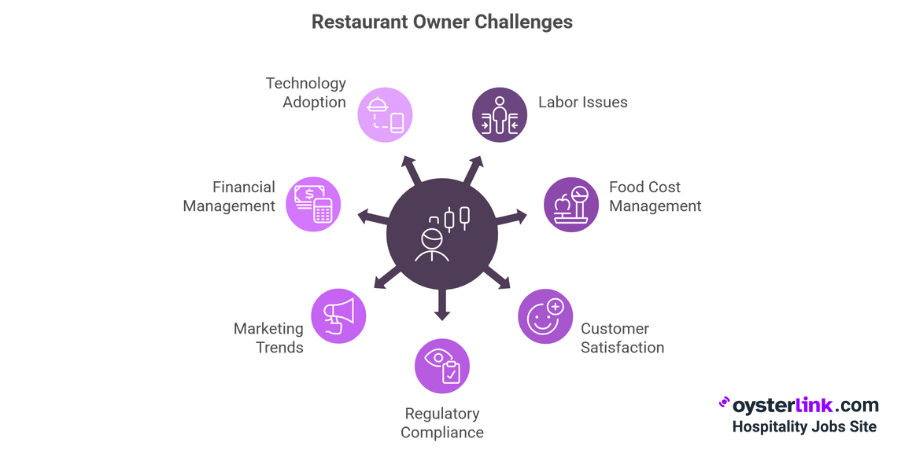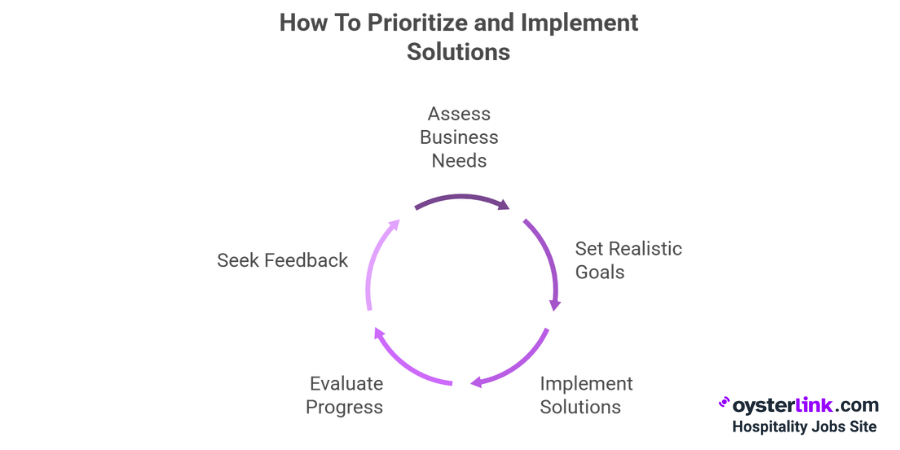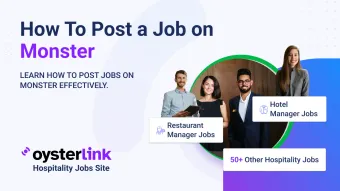Common Pain Points of Restaurant Owners: Key Takeaways
- Labor shortages — especially in the kitchen — remain the top challenge for restaurant owners, leading to high turnover and staffing instability. Proactive hiring and retention strategies are essential.
- Effective use of technology and digital inventory tools — such as real-time tracking and automated reorder alerts — can significantly reduce waste, spot cost overruns faster and control food costs.
- Sustaining customer satisfaction means keeping service consistent and managing online reviews on key channels like Google and Yelp, where a single comment can make a big impact.
- Staying compliant with health, safety and labor regulations prevents fines and last-minute panic during inspections. Keeping digital logs and scheduling routine audits helps minimize stress.
Running a restaurant is rewarding. Still, daily hurdles often leave owners — especially hands-on, independent operators — stressed and stretched thin.
It’s not easy juggling hiring, inventory, compliance and sometimes unpredictable customer expectations. Even seasoned pros have their hands full.
If you’re feeling that pressure, don’t worry — you’re far from alone. This article zooms in on common pain points of restaurant owners and shares step-by-step solutions.
The Most Common Pain Points of Restaurant Owners
Running a restaurant comes with a variety of challenges that can impact daily operations and long-term success. Here are some of the most frequently encountered issues that many restaurant owners face:
Labor shortages and staff turnover
Finding and keeping reliable team members — especially kitchen staff — is a constant headache. High turnover means endless recruiting, training and the risk of burnout for core staff when you’re shorthanded on a busy night.
Last-minute no-shows or lack of motivation during slow seasons can disrupt even the best-laid schedules. Take the rush before Sunday brunch, for example: one absent Cook can throw the whole line into chaos.
Food cost and inventory management
Unpredictable prices and supply chain hiccups make managing food costs tricky. Small inventory tracking mistakes or accidental spoilage really add up, eating into thin margins.
Quickly identifying overruns and controlling waste has become more important than ever. To do this effectively, implement precise inventory tracking systems, set par levels for high-turnover items, and conduct regular waste audits — these practices help you catch issues early before they escalate.
Additionally, training staff on proper storage and handling practices further reduces spoilage and loss.
Customer satisfaction and negative reviews
Keeping service and food quality consistently high is tough (especially during peak hours or when understaffed). A single negative review on Google or Yelp can feel personal and impact future business and team morale if it isn't addressed well.
Sometimes it’s the small details — like music volume or wait times — that spark unexpected online rants.
Regulatory compliance and health inspections
Local health, safety and labor laws are always shifting. Missing documentation or being caught off guard during a surprise inspection leads to stress, fines and operational hiccups.
Keeping up feels like a second job — one you can’t ignore, unfortunately. Learn more about how to prepare for health inspections to stay ahead of potential issues.
Marketing and keeping up with trends
Attracting new diners and keeping regulars engaged often means learning new things — for example, mastering social media basics or keeping up with local food trends. All this has to be done while running day-to-day operations, leaving little time or energy at the end of a shift.
Posting a picture of a new lunch special shouldn’t require a marketing degree, but sometimes it feels like it does! Consider these creative restaurant marketing ideas to help stand out without hiring a marketing agency.
Financial management and cash flow issues
Balancing bills, payroll and rising costs is a daily concern. Surprise cash flow dips or unclear records make it hard to stay ahead. As many owners have learned, one tough month can quickly start to affect your finances.
It’s not just about the numbers; it’s how quickly things can get out of hand if you don’t notice early on. Our article on fixing restaurant money problems fast offers practical steps to help you take back control of your finances.
Technology adoption and integration
Modern restaurants rely on tech, from digital Point-of-Sale (POS) to online reservations. Integrating new tools beyond the basics can be intimidating, especially if staff aren’t tech-savvy or if past investments have gone unused.
Choosing the right tech can feel like picking a needle out of a stack of needles.

Effective Solutions for Overcoming Restaurant Owner Pain Points
Addressing these common challenges requires practical strategies and targeted actions. Below, we outline some of the most effective solutions to help you navigate and resolve these pain points, enabling your restaurant to run more smoothly and profitably.
Streamlining recruitment and improving retention
Building a reliable, motivated team is essential for the smooth operation and long-term success of your restaurant. To effectively attract and retain quality staff, it’s important to establish clear processes and foster a positive work environment.
Here’s a checklist to guide you through developing practical strategies for hiring and keeping great team members:
- Write honest job descriptions including key tasks and soft skills needed.
- Use targeted hospitality recruitment platforms; consider asking regulars or trusted staff for referrals — they know your culture.
- Standardize onboarding with a clear training template: kitchen walk-throughs, safety tips, menu tastings and a “shadow shift.”
- Schedule informal staff check-ins (even 10 minutes post-shift) to catch issues early and boost morale.
- Celebrate wins — birthday notes, Staff shout-outs or “employee meal” days foster loyalty. (A local diner does “Taco Tuesdays” for team lunches and it’s a hit — even the Dishwasher brags about it!)
- Consider incentive programs for reliability (e.g., small bonuses for perfect attendance, especially during busy periods).
Implementing inventory management systems
An effective inventory management system is crucial for controlling food costs and minimizing waste. Proper implementation can streamline operations and improve accuracy, helping your team stay on top of stock levels and reduce costly errors.
Tips for non-techy teams:
- Start with digital tools that integrate with your POS (e.g., Toast, MarketMan, Upserve) to reduce double-entry and confusion.
- Train one team member as an “inventory champion”— allowing for quick help if you get stuck.
- Set par levels for fast-moving items; get automatic reorder alerts and weekly low-stock reports — don’t rely just on memory.
- Regularly review waste logs and discuss with staff — kitchen input often reveals quick wins for reducing loss.
Enhancing customer service and managing feedback
By actively engaging with feedback and investing in staff training, you can elevate your restaurant’s service quality and create positive experiences that keep diners coming back.
Start by scheduling regular service “refreshers,” brief training sessions — like a 10-minute pre-shift huddle — that keep the team sharp and aligned. Throughout the week, monitor reviews on Google and Yelp, capturing standout comments to share with your staff; this not only boosts morale but also highlights areas for improvement.
Respond promptly and genuinely to both positive and negative feedback, thanking customers and outlining steps to resolve any issues — demonstrating your commitment to their satisfaction.
To foster stronger connections, consider implementing a straightforward loyalty program, such as punch cards, birthday treats or personalized thank-you notes, that encourages repeat visits and builds lasting relationships with your guests.
Staying proactive with compliance and staff training
Remaining ahead of regulatory requirements and ensuring your staff are well-trained are crucial for smooth operations and avoiding fines or penalties. Being proactive helps you address issues before they become major problems and keeps your restaurant compliant with evolving laws and standards.
"How to stay ahead" checklist:
- Create digital folders for inspection docs and regulatory updates—share access with your Operations Manager.
- Schedule a 15-minute monthly “compliance check”— invite staff input on any new health or labor concerns.
- Sign up for local hospitality newsletters or Facebook groups to get early warnings about rule changes that affect your area.
- Offer occasional incentives for 100% completion of food safety or allergy training (a $10 coffee card works wonders!).
Smart marketing and leveraging online platforms
Using the right online strategies can greatly increase your restaurant’s visibility and draw in new customers. To make the most of your efforts, focus on a few key actions that help you connect authentically with your audience and stand out from the competition. Here are some practical steps to get started:
- Start by choosing one or two platforms — such as Instagram, TikTok or Facebook — where your diners are most active.
- Commit to posting about three times a week, sharing genuine photos of your daily specials, behind-the-scenes moments, or staff shout-outs to keep your content relatable and engaging.
- Encourage your regular customers to tag your page or leave reviews after their visits, helping your reach grow organically.
- Partner with a local foodie influencer for a tasting or special event to boost your profile within the community.
- Enlist tech-savvy friends, family or staff — like a marketing-minded niece — to assist with creating videos or reels, making your content more lively and appealing.
Advanced financial tracking and budgeting tools
Maintaining a clear understanding of your restaurant’s finances is vital for ensuring profitability and making informed business decisions. Implementing advanced tracking and budgeting tools helps you stay on top of cash flow, control costs and identify financial opportunities or red flags early.
Use restaurant-friendly accounting software that allows for real-time expense tracking, giving you an up-to-date view of your financial health. Set a recurring appointment — such as every Monday morning — to review cash flow, identify any anomalies and take corrective action promptly.
Finally, regularly compare your actual financial results to your budget. This helps you spot variances early and stay aware of potential issues. With this proactive approach, you can adjust strategies as needed, rather than waiting for surprises at year-end.
Choosing the right technology solutions
Finding the best technology tools for your restaurant can significantly improve efficiency and guest satisfaction. To ensure you make smart investments, follow a practical approach that emphasizes understanding your needs, testing options and tracking results.
Here are some key steps to help you select and implement the right solutions for your business:
- List out pain points first (e.g., “I need to reduce no-shows for reservations”).
- Demo new software before buying — see if it fits your workflow and if your team is comfortable using it.
- Assign a “tech lead” Staffer to champion and train others — avoid rolling out too much, too fast.
- Track usage and value after one month; don’t hesitate to swap out tools that don’t earn their keep.
Sometimes, hiring a Restaurant Consultant is worth it for larger integration projects.
How To Prioritize and Implement Solutions
Addressing the various challenges within your restaurant requires a thoughtful and organized approach. Prioritizing effectively ensures that your efforts are focused on the most impactful areas, enabling meaningful progress without overwhelming yourself or your team.
Assessing business needs and identifying key pain points
Begin by gathering data from POS reports, staff and guest feedback and recurring notes from team meetings. An effective and informal way to gain honest insights is to hold a quarterly brainstorming dinner — sharing a pizza can foster open discussion and inspire creative problem-solving more than a traditional meeting.
Setting realistic goals and timelines
Once you've identified the key issues, break down complex problems into micro-goals. For example, if your goal is to improve kitchen retention, set a specific target like “reduce kitchen turnover by 20% over six months.”
Assign clear accountability for each task and make timelines visible by posting them in your Staff area or digital planner. Concentrate on tackling just one or two major changes at a time to prevent burnout and maintain focus, since juggling too many priorities can lead to inaction.
Continuous evaluation and improvement
Implement recurring calendar check-ins — monthly or quarterly — to review progress, assess what strategies are working and identify areas needing adjustment.
Regularly seek candid feedback from staff and select customers. Make sure to keep everyone informed about how their input has contributed to positive changes. For example, improvements can include shorter wait times, new menu items or enhanced service.
This ongoing evaluation ensures your solutions remain effective and aligned with your business goals.












Loading comments...